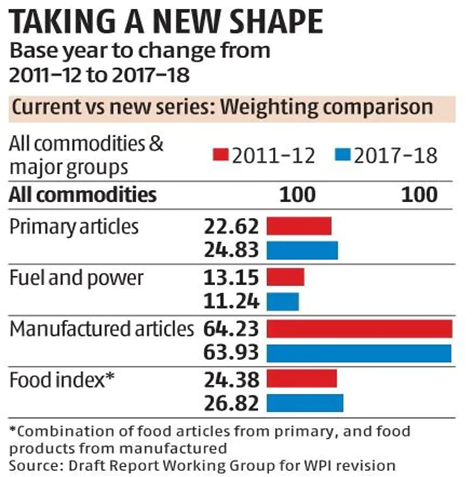In News: According to recently released official data, the Wholesale Price Index (WPI) - based inflation rate reached a record high of 15.1% in April, owing to increases in the cost of vegetables, fruits, milk and fuel.
What’s in today’s article:
- Wholesale Price Index (Definition, description, WPI in India)
- News Summary (Recent figures, what caused the spike, impact)
Wholesale Price Index (WPI):
- Definition: WPI represents the price of goods at a wholesale stage e., goods that are sold in bulk and traded between organizations instead of consumers. WPI is used as a measure of inflation in some economies.
- Description:
- WPIs are reported monthly in order to show the average price changes of goods.
- The total costs of the goods being considered in one year are then compared with the total costs of goods in the base year.
- The total prices for the base year are equal to 100 on the scale. Prices from another year are compared to that total and expressed as a percentage of change.
- WPI in India:
- It is used as an important measure of inflation in India. It takes into account the change in price of goods only.
- WPI data is published by the Office of Economic Adviser, Ministry of Commerce and Industry, Government of India.
- The current series of WPI - with base year of 2011-12 - was the seventh revision of WPI and implemented from 2017 onwards.

- Major components of WPI:
- Primary articles, which is subdivided into Food Articles (Cereals, Paddy, Wheat, Pulses, Vegetables, Fruits, Milk, Eggs, Meat & Fish, etc.) and Non-Food Articles (Oil Seeds, Minerals and Crude Petroleum).
- Fuel & Power, which tracks price movements in Petrol, Diesel and LPG.
- The biggest basket is Manufactured Goods (Textiles, Apparels, Chemicals, Cement, Metals, Sugar and Tobacco Products, Vegetable and Animal Oils, etc.)
- WPI Food Index: A sub-index within WPI, including Food Articles from the Primary Articles basket and the food products from the Manufactured Products basket.
-
- Fiscal and monetary policy changes are greatly influenced by changes in WPI. Also, it is an easy and convenient method to calculate inflation.
- The main criticism about WPI is that it does not account for inflation at the level of the ordinary public because they do not buy products at wholesale prices. WPI also excludes the service sector.
News Summary:
- Recent figures:
- Inflation in wholesale prices hit 15.1% in April, the highest in the current data series, from 14.5% in March.
- WPI inflation has been in double digits for the thirteenth months in a row now.
- The previous high inflation rate recorded in the current series of the WPI with a base year of 2011-12, was 14.9% in November 2021.
- What caused the spike?
- The heatwave led to a spike in prices of perishables such as fruits, vegetables and milk, which, along with a spike in tea prices, pushed up primary food inflation.
- Fuel inflation rose to 38.66%, while inflation for manufactured products rose to 10.85% and food price inflation rose to 8.9%. Primary articles were the only group to experience a slowing in inflation, which fell to 15.45% in April from 15.54% in March.
- Much of the inflationary surge is being attributed to the Russia-Ukraine crisis, with retail inflation accounting for three-fourths of the index.
- Retail inflation also reached an 8-year high of 7.79% in April, according to the recent data.
- Impact of high WPI inflation rates:
- With WPI inflation remaining in double-digits, the probability of a repo hike in the June monetary policy has risen further.
- With the source of inflation being global supply issues rather than robust domestic demand, economists continue to believe that tightening will dampen the nascent economic recovery without having a corresponding impact on the source of inflationary pressures.









